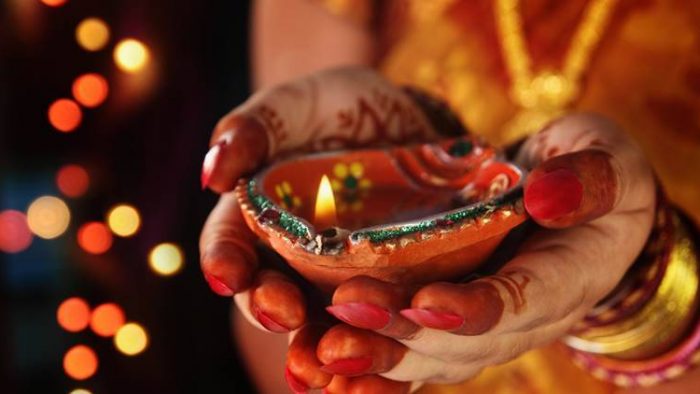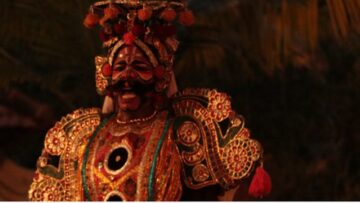Deepavali or the festival of lights is one of the most important festivals in the Hindu tradition, with many important events, such as the slaying of Narakasura, returning of Rama and Sita to Ayodhya, Nachiketa’s immortal conversations with Lord Yama, have all believed to have occurred during the four days of Deepavali.
One factor, which pervades the diverse celebrations of the festival across the country is the lighting of the lamps, which symbolically denotes the removal of darkness through light and of ignorance through knowledge.
The correlation between light and knowledge on the one hand, and between darkness and ignorance on the other, is very deep in Hindu consciousness and pervades the entire corpus of Hindu scriptures, starting with the Vedas.
Rigveda, for example, begins with a hymn dedicated to Agni, the source of divine illumination on earth. There are a large number of verses in the Vedas, including the Upanishads dedicated to Surya- the very embodiment of light and divine knowledge.
Then, we have the famous Sandhya Upasana and Gayatri mantra, which is all about appealing to the divine to illuminate our minds with the light of knowledge.
The celebration of Deepavali, is thus, a manifestation, an externalization of the inner realization that the darkness of ignorance is removed only through the light of knowledge. And hence, it becomes imperative that we make an attempt to understand this inner journey from darkness to light.
This article tries to make one such attempt using the popular mantra from the Brihadaranyaka Upanishad called “Pavamana Mantras”, which is singularly devoted to this journey towards the light.
Pavamana Mantras
The famous Pavamana Mantras (purifying mantras) that appeals to be taken from darkness to light occurs in Brihadaranyaka Upanishad, as part of verse 1.3.28. The three Pavamana Mantras are:
असतो मा सद्गमय
तमसो मा ज्योतिर्गमय
मृत्योर्मामृतं गमय
Translation: Lead me from unreal/ temporary existence to real/absolute existence; lead me from the darkness of ignorance to the light (of knowledge); lead me from death to immortality.
These are pretty straight forward mantras, which are widely used by people. Yet, they have a deeper meaning and context.
“Sat” is often translated as “truth” and “Asat” as “falsehood”. But, in Vedanta, “Sat” has a very specific meaning: that which exists always without a beginning and without an end. Hence, Vedanta defines the truth or reality in terms of Absolute eternal existence, which is called variously as “Brahman”, “Atman” or simply “Tat”.
On the other hand, “Asat” is all those, which either does not exist, or have only temporary existence. Thus, the entire world, with all its infinite number of objects, is “Asat”, because they are subjected to birth and death and hence their existence is temporary.
“Tamas” literally means “darkness” and it refers to the darkness of ignorance, whereas “Jyotih” means light and it refers to light of knowledge. Vedanta enunciates that the whole creation is a result of Avidya (ignorance) about the true nature of Brahman/Atman.
Brahman is the ultimate absolute existence, which is without birth, without change, and without duality and multiplicity. Yet, the cosmos (Jagat), which has manifested from Brahman, undergoes change, undergoes birth and death and is full of multiplicity.
To the question, how did Brahman, which is birthless, take birth as Jagat, Vedanta answers that this birth is merely an appearance rooted in ignorance about the true nature of Brahman and in reality Brahman is birthless. To clarify, Vedanta literature offers examples of how a rope is mistaken to be a snake due to the mistaken perception (ignorance).
The snake is perceived by the eyes and it exists as long as it is perceived. But, the moment, the truth that it is only a rope is revealed, the perception of snake vanishes. Similarly, Vedanta explains that the world has no independent existence, it derives its apparent existence from Brahman like the mistaken snake derived from the rope; and once the true nature of Brahman is perceived, the perception of ‘separate’ universe ceases and Brahman alone shines forth.
Thus, “Tamas” refers to the perception of the Jagat with all its objects as separate entities, which is rooted in ignorance about Brahman, whereas “Jyotih” refers to the perception of the true nature of Brahman as one infinite whole. The former causes bondage to the Karmic cycle of birth and death, whereas the latter constitutes Moksha or liberation from the Karmic cycle.
“Mrutyu” means “Death” and refers to the cosmos and all its objects, because it has temporary existence and hence, undergoes death. “Amrita”, on the other hand, refers to Brahman, which is birthless and hence, also without death, i.e. immortal.
The former is the reference to all kinds of limitations and suffering that one is subjected to in this material universe, whereas the latter is a reference to a state of immortal bliss.
To sum up, the Pavamana mantras are simply prayers that requests Brahman to lead one from this physical existence, this Karmic cycle of birth and death, which is characterized by unreality, ignorance, and death to the state of liberation from the Karmic cycle, which is Existence, Knowledge, and Immortal Bliss. In other words, an appeal to lead one to Moksha is the broad import of the mantras.
But, to fully understand the complete meaning and nuances, it is important to study the context and the application of the mantra as enunciated in the Brihadaranyaka Upanishad.
Adi Shankaracharya in his Bhashya on the verse 1.3.28, gives the context and practical usage of the three mantras thus: “A repetition of Mantras is being prescribed for one who knows the vital force (प्राणविज्ञानवतो) as such. The meditation by knowing which one is entitled to this repetition of Mantras has been mentioned.
Now, because this repetition of Mantras by one possessed of such knowledge produces the result of elevation to divinity, therefore it is being described here. This repetition, being connected with chanting, maybe thought applicable to every chant; so it is restricted by the mention of the Pavamanas.
But since one may think that it should be done with all the three Pavamanas, the time is being further restricted: The priest called Prastotr indeed recites the Saman. While he recites it, i.e. when he begins to chant the Saman, these Mantras are to be repeated.
And this repetition of Mantras is called Abhyaroha, because through this repetition one possessed of such knowledge ‘advances towards’ the realization of one’s innate divinity.” [Brihadaranyaka Upanishad – Shankara Bhashya translated by Swami Madhavananda].
Thus, the context of the mantras is Prana-upasana for the attainment of Hiranyagarbha and it should be recited, when the priest called Prastotr starts chanting Saman.
Now let us take a deeper look into how the Brihadaranyaka Upanishad explains the meaning of Pavamana Mantras in the context of Prana-upasana. But, before that a short note on Hiranyagarbha.
Hiranyagarbha: The First Born
Vedanta envisages Brahman as being both transcendent and immanent, as unconditioned and conditioned. Brahman in its true absolute transcendent state is birthless, changeless, infinite whole- Existence, Knowledge, Bliss- and is called as “Nirguna Brahman” or “Para-Brahman”, whereas same Brahman in his immanent state of manifestation, with its mysterious power of Maya manifesting the Universe as an appearance, is called as “Saguna Brahman”.
This Saguna Brahman is in-turn understood as “Karana Brahman” or the undifferentiated cause of the universe, and as “Karya Brahman”- the manifested Universe, which is the effect.
Bhagavad Gita refers to Brahman in its Karya, Karana, and Para aspect as Kshara Purusha, Akshara Purusha, and Purusha Uttama, respectively. The Upanishads call Nirguna Brahman and Karya Brahman as Para (Higher) and Apara (Lower), respectively.
It is this Karya or Apara Brahman, which is called Hiranyagarbha- the Golden (cosmic) womb, because from it arises all the realms, objects, and beings of the universe and also because in him the entire universe exists in its subtle state as in a womb.
Hiranyagarbha is, thus, the manifested Universe in its entirety. It is also called “Prathamaja”-the firstborn because it is the first manifestation from Karana Brahman-the cause.
This Hiranyagarbha or Lower Brahman is also called as “Prana” or Life Breath, because, in its aspect of life-force, it sustains the entire manifested Universe, including all beings.
Thus, Prana-Upasana is the worship of Hiranyagarbha, worship of Brahman in his lower (Apara) aspect. Upanishads describe that one who attains this Hiranyagarbha becomes free from the bondage of the physical universe and hence free from limitations like sorrow, pain, heat, cold, etc.
Since, Hiranyagarbha is the lower aspect of Para-Brahman, and hence near to it, attaining Hiranyagarbha is considered as “Relative Immortality” while attaining Para-Brahman, through Brahma-Jnana (Atma-Jnana) is called Moksha-Absolute Immortality.
Thus, attaining Hiranyagarbha brings one very close to attaining ultimate Moksha.
With this short note about Hiranyagarbha, let us now look into the Pavamana mantras.
From Asat to Sat
Brihadaranyaka Upanishad, verse 1.3.28, does not simply give the three Pavamana Mantras but also explains them. While explaining the first mantra: “असतो मा सद्गमय”, it says:
स यदाहासतो मा सद्गमयेति, मृत्युर्वा असत्, सदमृतम्, मृत्योर्माऽमृतं गमयामृतं मा कुर्वित्येवैतदाह
Translation: When the mantra (verse) says: “Lead me from the unreal to the real,” “the unreal” means death and the “real,” immortality; so it says, “From death lead me to immortality,” that is to say, “Make me immortal.” [Brihadaranyaka Upanishad, Translation by Swami Nikhilananda]
Thus, the Upanishad equates “Asat” with death and “Sat” with immortality. We have already seen how Asat is a reference to a temporary Universe, which is rooted in ignorance is binding and limiting and hence is “death”; whereas “Sat” being birthless, ever-free, and the only true existence is “immortal”.
But, in the context of the Upanishad, Shankaracharya gives a more specific contextual meaning to these terms. He explains that the term “Asat” and “Mrutyu” in the context of this first mantra, refers to thoughts and actions rooted in our Svabhava (innate nature), i.e. the thoughts and actions performed under the influence of Arishadvargas (mental passions): lust, anger, attachment, greed, pride, and jealousy, being driven by one’s Svabhava, rooted in Prarabdha Karmas and past life Samskaras.
Such, actions and thoughts impelled by the mental passions rooted in Svabhava are called “Asat”, because they degrade one into more darkness of ignorance by increasing their bondage to the temporary universe; they are called “Mrutyu”, because such increased bondage prevents one to overcome the limitations of physical existence, starting with death.
On the other hand, Shankaracharya explains, “Sat” is a reference to “actions and thoughts as prescribed in the Shastras (scriptures)”. Here the reference of “actions” and “thoughts” is to the practice of Dharma-Anushtana (the practice of Dharma) and Devata Upasana as per the guidance of the Shastras, respectively.
Dharma Anushtana involves practice of one’s own righteous duties (Svadharma) and avoidance of unrighteous activities (Adharma), with Shastras acting as the guide.
Svadharma, in turn, has been categorized into Samanya or common duties like truth, non-injury, cleanliness, etc. and Vishesha or Special, which is tailor-made for each person based on his/her inner temperaments, time, location, and situations. Devata Upasana involves meditation on Hirayangarbha using various means.
These scripturally aligned Dharmic thoughts and actions viz. Dharma Anushtana and Devata Upasana, have been termed “Sat” because they purify the mind and create an awareness that the material world is temporary and Brahman alone is permanent reality and since, these Dharmic actions and thoughts also help one to overcome limitations of the physical body, and hence, takes a person closer to Moksha, it is called as “Amrutam”.
Here, “Amrutam” specifically refers to transcending physical existence and attaining a state of “Divinity” by merging into Hiranyagarbha. Since Dharmic thoughts and actions facilitate attaining Hiranyagarbha, it is also referred to as “Amrutam’.
Summarizing the meaning of this mantra, Shankaracharya writes:
स्मादसतः असत्कर्मणोऽज्ञानाच्च, मा माम्, सत् शास्त्रीयकर्मविज्ञाने, गमय, देवभावसाधनात्मभावमापादयेत्यर्थः
Translation: Therefore, the meaning is ‘From evil actions and ignorance, lead me to actions and thoughts that are regulated by the scriptures, i.e. help me identify myself with those things that lead to divinity.’ [Brihadaranyaka Upanishad – Shankara Bhashya translated by Swami Madhavananda].
Thus, renouncing unrestrained thoughts and actions impelled by mental passions like desire, lust, and selfishness and embracing a life of Dharma and Upasana by practicing one’s righteous duties and meditation constitute the first stage of the inner spiritual journey from darkness to Light.
From Tamas to Jyotih
Now, coming to the second mantra: तमसो मा ज्योतिर्गमय, the Brihadaranyaka Upanishad, verse 1.3.28 says:
तमसो मा ज्योतिर्गमयेति मृत्युर्वै तमो ज्योतिरमृतं मृत्योर्मामृतं गमयामृतं मा कुर्वित्येवैतदाह
Translation: When it says: “From darkness lead me to light,” “darkness” means death and “light,” immortality; so it says: “From death lead me to immortality,” that is to say, “Make me immortal.” [Brihadaranyaka Upanishad, Translation by Swami Nikhilananda]
The Upanishad takes a similar approach as in the previous mantra. It equates Tamas (darkness) with death and Jyotih (light) with Immortality. And as we saw in the beginning, Tamas is a reference to the manifested Universe, which is rooted in Avidya or Ignorance, whereas Jyotih is a reference to Brahman, who alone shines as Sat-Chit-Ananda or Existence-Knowledge-Bliss.
But, as with the previous mantra, there is a deeper and more contextualized meaning in this mantra as well. This refers to the second stage in the inner journey from darkness to Light.
Shankaracharya in his commentary takes the reference of Tamas to the entire Universe rooted in Avidya/Ignorance and says, this ignorance is called Tamas or darkness because all ignorance is veiling in nature.
That is, since, Avidya veils the true nature of Brahman as being ever free and birthless, it is called Tamas or darkness, and since, through this veiling, it gives rise to this universe, whose characteristics is death (i.e. transience), it is called as Mrutyu or death.
Jyotih, on the other hand, is the opposite of Tamas. It is the light of knowledge, it is that, which shines. It is a reference to the state of Divinity, the state of Knowledge: Hiranyagarbha. Hirayangarbha is called as Amruta or immortal, because it is imperishable, owing to have already transcended the physical and subtle limitations like cold, heat, pain, sorrow, and the physical cycle of birth and death.
It is also called immortal, because being “Apara or Lower Brahman”, it is close to Para-Brahman, attaining which constitutes Absolute Immortality. Thus, the second mantra constitutes a description of Hiranyagarbha and its attainment.
Comparing the first mantra with the second, Shankaracharya rightly points out:
पूर्वो मन्त्रोऽसाधनस्वभावात्साधनभावमापादयेति; द्वितीयस्तु साधनभावादप्यज्ञानरूपात्साध्यभावमापादयेति
Translation: The first mantra means, help me to identify myself with the means of realization, instead of with things that are not such; while the second one means, help me to go beyond that even- for it is a form of ignorance- and attain identity with the result. [Brihadaranyaka Upanishad – Shankara Bhashya translated by Swami Madhavananda].
Thus, in the context of Prana Upasana, the first mantra speaks about the means, while the second about the result. The ultimate goal of Prana Upasana is the attainment of Hiranyagarbha, which is a state of light, knowledge, relative immortality.
The means for attaining this is the practice of Dharma Anushtana and Devata Upasana. The first mantra, asks one to renounce activities rooted in desire, selfishness, and mental passions and take up the means, while the second mantra asks one to perfect the means and finally attain the goal.
This attainment of Hiranyagarbha constitutes the second stage in the inner journey from darkness to Light.
From Mrutyu to Amrita
Regarding the third mantra: मृत्योर्मामृतं गमय, the Brihadaranyaka Upanishad, verse 1.3.28 says:
मृत्योर्मामृतं गमयेति नात्र तिरोहितमिवास्ति
Translation: In the verse: “From death lead me to immortality,” there is nothing that is hidden. [Brihadaranyaka Upanishad, Translation by Swami Nikhilananda]
Explaining this, Shankaracharya writes:
मृत्योर्मामृतं गमयेति पूर्वयोरेव मन्त्रयोः समुच्चितोऽर्थस्तृतीयेन मन्त्रेणोच्यत इति प्रसिद्धार्थतैव । नात्र तृतीये मन्त्रे तिरोहितमन्तर्हितमिवार्थरूपं पूर्वयोरिव मन्त्रयोरस्ति; यथाश्रुत एवार्थः
Translation: The third mantra, ‘From death lead me to immortality’, gives the combined meaning of the first two, and is quite clear. In this ‘the meaning does not seem to be hidden’ as in the first two, i.e. it should be taken literally. [Brihadaranyaka Upanishad – Shankara Bhashya translated by Swami Madhavananda].
In other words, in the context of the Prana-Upasana, the third mantra is a restatement of the combined import of the first and second mantra. It is a prayer to be taken from physical existence, which is of the nature “death” to the state of Hiranyagarbha, which is a state of relative “immortality”.
But, is there another layer of meaning to this third mantra beyond the specific context of Prana Upasana? If we look at general Vedantic literature, especially the Upanishads, they often contain instructions, which at one level refers to the path towards Apara Brahman and at another level refers to the path towards Para Brahman [for example Upasana on OM in Mandukya Upanishad], or contain two separate sets of instructions for reaching Apara and Para Brahman.
Thus, analyzing from this perspective, the first and second mantra clearly refers to the path that leads to Apara or lower Brahman. The third mantra could be understood as a reference to Para-Brahman through the path of Jnana.
The “Mrutyu” or death in the third mantra, may well be a reference to the state of Hiranyagarbha, in the sense that even this state is, after all, an “Effect” and retains duality, whereas Para-Brahman is non-dual existence. We may recall our earlier note on Hiranyagarbha.
He is the firstborn and hence, is subjected to the limitation of cause and effect, which is being referred to as “death”, since, what is born, must end eventually. On the other hand, “Amrutha” in the third mantra refers to the state of Jnana and Moksha, the attainment of Para-Brahman, which is truly free, beyond duality, and immortal.
While the first and second mantra could be understood as instructions regarding Dharma Anushtana and Devata Upasana to reach Hiranyagarbha, this third mantra is an instruction on Atma-Vichara or Self-enquiry- the path to reach Moksha.
Vedanta envisages Para-Brahman as inhabiting all objects and beings as their innermost true Self- Atman and hence, attainment of this innermost Atman constitutes attainment of Brahman.
Self-inquiry is a process by which the false identifications of this Atman with non-Self entities of body and mind due to Avidya removed and Atman or Brahman is allowed to shine without obstructions.
Thus, Self-enquiry is a process to remove the duality of subject and object rooted in Avidya and hence, takes one truly from death to Absolute immortality.
This travel from the state of Hiranyagarbha, which is subjected to subject-object, cause-effect duality to the state of non-dual Para Brahman, which is truly immortal constitutes the third and final state of the journey from darkness to light.
This journey to the inner light is best illustrated in the conversation between Rishi Yajnavalkya and Janaka, the King of Videha, which appears in Brihadaranyaka Upanishad, verse 4.3.1-8. Here is the translation of the conversation as given by Swami Nikhilananda:
Yajnavalkya called on Janaka, Emperor of Videha. He said to himself: “I will not say anything.” But once upon a time Janaka, Emperor of Videha, and Yajnavalkya had had a talk about the Agnihotra sacrifice and Yajnavalkya had offered him a boon.
Janaka had chosen the right to ask him any questions he wished and Yajnavalkya had granted him the boon. So it was the Emperor who first questioned him.
Yajnavalkya, what serves as light for a man?” “The light of the sun, O Emperor,” said Yajnavalkya, “for with the sun as light he sits, goes out, works and returns.” “Just so, Yajnavalkya.”
“When the sun has set, Yajnavalkya, what serves as light for a man?” “The moon serves as his light, for with the moon as light he sits, goes out, works and returns.” “Just so, Yajnavalkya.”
“When the sun has set and the moon has set, Yajnavalkya, what serves as light for a man?” “Fire serves as his light, for with fire as light he sits, goes out, works and returns.” “Just so, Yajnavalkya.”
“When the sun has set, Yajnavalkya and the moon has set and the fire has gone out, what serves as light for a man?” “Speech (sound) serves as his light, for with speech as light he sits, goes out, works and returns. Therefore, Your Majesty, when one cannot see even one’s own hand, yet when a sound is uttered, one can go there.” “Just so, Yajnavalkya.”
“When the sun has set, Yajnavalkya and the moon has set and the fire has gone out and speech has stopped, what serves as light for a man?” “The Self, indeed, is his light, for with the Self as light he sits, goes out, works and returns.”
“Which is the Self?” “This purusha which is identified with the intellect (vijnanamaya) and is in the midst of the organs, the Self— indulgent light within the heart (intellect). Assuming the likeness of the intellect, it wanders between the two worlds; it thinks, as it were and moves, as it was being identified with dreams, it transcends this waking world, which represents the forms of death (ignorance and its effects).
“That person (the individual self), when he is born, that is to say, when he assumes a body, is joined with evils and when he dies, that is to say, leaves the body, he discards those evils.”
Deepavali or the festival of lights, thus, is not only about lighting the external lamps, but it is also about an individual’s inner journey from a state of darkness of ignorance to a state of light of knowledge and freedom. Realizing this, each and every person must make a start, take the first step in this inner journey towards freedom and emancipation.
Disclaimer: The facts and opinions expressed in this article are the personal opinions of the author. Indic Today does not assume any responsibility or liability for the accuracy, completeness, suitability, or validity of any information in this article.
This Series was first published on India Facts
Disclaimer: The opinions expressed in this article belong to the author. Indic Today is neither responsible nor liable for the accuracy, completeness, suitability, or validity of any information in the article.










